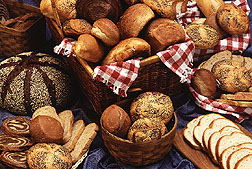This page has been archived and is being provided for reference purposes only. The page is no longer being updated, and therefore, links on the page may be invalid.
| Read the magazine story to find out more. |
|
|
|
|
USDA Scientists Produce Palatable Gluten-Free Bread
By Sharon DurhamDecember 22, 2010
A process to produce high-quality, gluten-free bread has been developed by U.S. Department of Agriculture (USDA) scientists in Manhattan, Kan. Millions of Americans affected by celiac disease are unable to digest gluten, a protein in flour from grains such as wheat, barley and rye.
Chemists Scott Bean and Tilman Schober at the Agricultural Research Service (ARS) Grain Quality and Structure Research Unit found that by removing a certain amount of fat from a corn protein called zein, they were able to produce a dough more similar to wheat dough, and free-standing, hearth-type rolls that resemble wheat rolls. ARS is the chief intramural scientific research agency of USDA.
Bean and Schober had some success developing gluten-free pan bread from other grains, but they couldn't make free-standing rolls because the rolls spread out too much. According to Bean, the bread was considered lower in quality than comparable wheat bread. Gluten-free grains include corn, sorghum, and rice.
In previous studies, Bean and Schober found that zein-a readily available byproduct from corn wet milling and fuel-ethanol production-could be used to make dough that was more similar to wheat dough. The dough still didn't meet their standards, though, because it lacked strength, and the rolls produced from it were too flat.
Bean and Schober discovered that removing more of the fat from the zein protein's surface allowed the proteins to stick to each other much like wheat proteins do, giving the zein-based dough the same elastic properties as wheat dough.
According to Bean, while the experiment made more acceptable dough, sorghum may prove to be a better grain to use since it is a gluten-free grain. Bean used corn as an intermediate step toward achieving the ideal in gluten-free breads: a wheat-like dough using non-wheat proteins, resulting in products with a fluffy, light texture.
This research may prove useful for the 2 to 3 million Americans who have celiac disease, a condition in which the human immune system erroneously attacks gluten proteins, causing severe diarrhea and inability to absorb nutrients. Gluten-free palatable rolls from corn, rice and sorghum would be a welcome addition to their diet.
The research results were published in the Journal of Cereal Science and in the November/December 2010 issue of Agricultural Research magazine.

